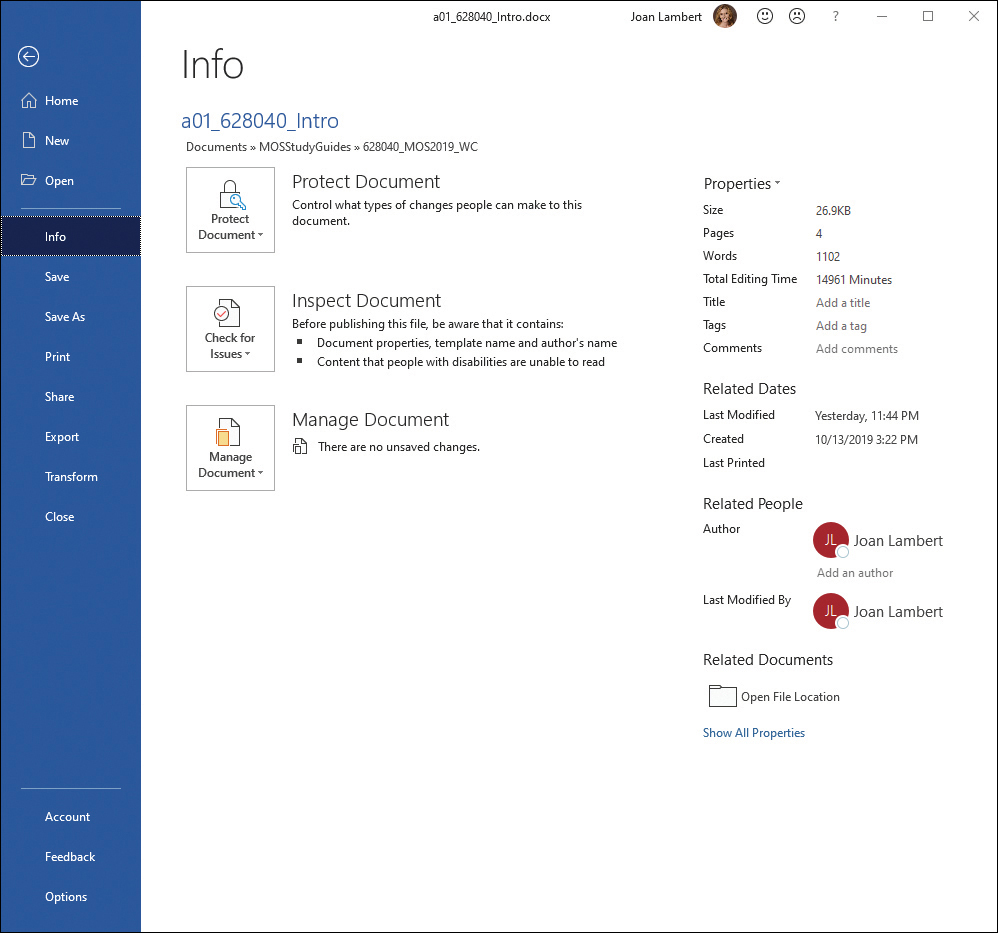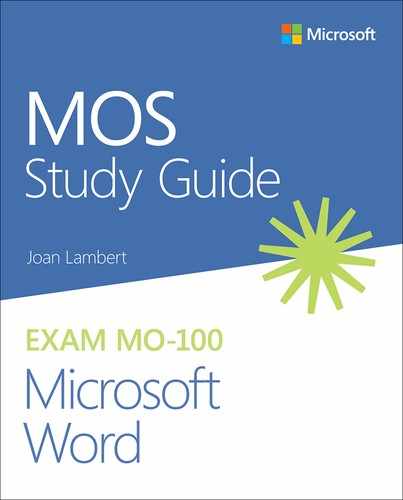 Microsoft Office Specialist
Microsoft Office Specialist
Exam MO-100
Microsoft Word 2019
This book covers the skills you need to have for certification as a Microsoft Office Specialist in Word 2019. Specifically, you need to be able to complete tasks that demonstrate the following skill sets:
Manage documents
Insert and format text, paragraphs, and sections
Manage tables and lists
Create and manage references
Insert and format graphic elements
Manage document collaboration
With these skills, you can create, populate, format the content of, and manage the types of documents most commonly used in a business environment.
Prerequisites
We assume that you have been working with Word 2019 for at least six months and that you know how to carry out fundamental tasks that are not specifically mentioned in the objectives for this Microsoft Office Specialist exam. Before you begin studying for this exam, you might want to make sure you are familiar with the information in this section.
Move around in a document
You can view various parts of the active document by using the vertical and horizontal scroll bars. Using the scroll bars does not move the cursor—it changes only the part of the document displayed in the window. For example, if you drag the vertical scroll box down to the bottom of the scroll bar, the end of the document comes into view, but the cursor stays in its original location.
Here are some other ways to use the scroll bars:
Click the up or down scroll arrow on the vertical scroll bar to move the document window up or down one line of text.
Click above or below the scroll box to move up or down one screen.
Click the left or right scroll arrow on the horizontal scroll bar to move the document window to the left or right several characters at a time.
Click to the left or right of the scroll box to move left or right one screen.
You can also move around in a document by moving the cursor. You can click to place the cursor at a particular location, or you can press a key or a key combination to move the cursor.
The following table shows the keys and key combinations you can use to move the cursor.
Pressing this key or key combination |
Moves the cursor |
|---|---|
Left Arrow |
Left one character at a time |
Right Arrow |
Right one character at a time |
Down Arrow |
Down one line at a time |
Up Arrow |
Up one line at a time |
Ctrl+Left Arrow |
Left one word at a time |
Ctrl+Right Arrow |
Right one word at a time |
Home |
To the beginning of the current line |
End |
To the end of the current line |
Ctrl+Home |
To the beginning of the document |
Ctrl+End |
To the end of the document |
Ctrl+Page Up |
To the beginning of the previous page |
Ctrl+Page Down |
To the beginning of the next page |
Page Up |
Up one screen |
Page Down |
Down one screen |
Select text
Before you can edit or format text, you need to select it. You can select any amount of text by dragging through it. You can select specific units of text as follows:
To select a word, double-click it. The word and the space following it are selected. Punctuation following a word is not selected.
To select a sentence, click anywhere in the sentence while holding down the Ctrl key. The first character in the sentence through the space following the ending punctuation mark are selected.
To select a paragraph, triple-click it. The paragraph and paragraph mark are selected.
You can select adjacent words, lines, or paragraphs by positioning the cursor at the beginning of the text you want to select, holding down the Shift key, and then pressing an arrow key or clicking at the end of the text that you want to select.
To select non-adjacent blocks of text, select the first block, hold down the Ctrl key, and then select the next block.
To select a block of text quickly, you can use the selection area—the empty area to the left of the document’s text column. When the pointer is in the selection area, it changes from an I-beam to a right-pointing arrow. From the selection area, you can select specific units of text as follows:
To select a line, click in the selection area to the left of the line.
To select a paragraph, double-click in the selection area to the left of the paragraph.
To select an entire document, triple-click anywhere in the selection area.
To deselect text, click anywhere in the document window other than the selection area.
Cut, copy, and paste content
Word offers several methods of cutting and copying content. After selecting the content, you can click buttons on the ribbon, use a keyboard shortcut, or right-click the selection and click commands on the shortcut menu. Cutting or copying content places it on the Microsoft Office Clipboard. You can paste content that is stored on the Clipboard into a document (or any Office file) by using commands from the ribbon, shortcut menu, or keyboard, or directly from the Clipboard.
Experienced users might find it fastest to use a keyboard shortcut. The main keyboard shortcuts for editing tasks are shown in the following table.
Task |
Keyboard shortcut |
|---|---|
Cut |
Ctrl+X |
Copy |
Ctrl+C |
Paste |
Ctrl+V |
Undo |
Ctrl+Z |
Repeat/Redo |
Ctrl+Y |
Exam Strategy When you paste content into a Word document, the Paste Options menu presents options for formatting the pasted content. Exam MO-100 does not include items that test your knowledge of the Paste Options menu.
You can move or copy text by dragging it within the same document. To copy the selection instead of moving it, hold down the Ctrl key while you drag. The dragged text is not stored on the Clipboard, but the Paste Options list is available when you release the mouse button so that you can adjust the formatting of the moved or copied content.
See Also For information about managing the Clipboard and pasting content in alternative formats, see “Objective 2.1: Insert text and paragraphs.”
Access program commands and options
Commands for working with Word documents (rather than document content) are available from the Backstage view. You display the Backstage view by clicking the File tab on the ribbon.

The links in the left pane of the Backstage view provide access to information about the current document, commands for working with the document, or commands for working with Word. To display the Home, New, Open, Info, Save, Save As, Print, Share, Export, Transform, Account, or Feedback page, click the page name in the left pane.
You manage many aspects of Word functionality from the Word Options dialog box, which you open by clicking Options in the left pane of the Backstage view.

The Word Options dialog box has 11 separate pages of commands, organized by function. To display the General, Display, Proofing, Save, Language, Ease of Access, Advanced, Customize Ribbon, Customize Quick Access Toolbar, Add-ins, or Trust Center page of the Word Options dialog box, click the page name in the left pane.
